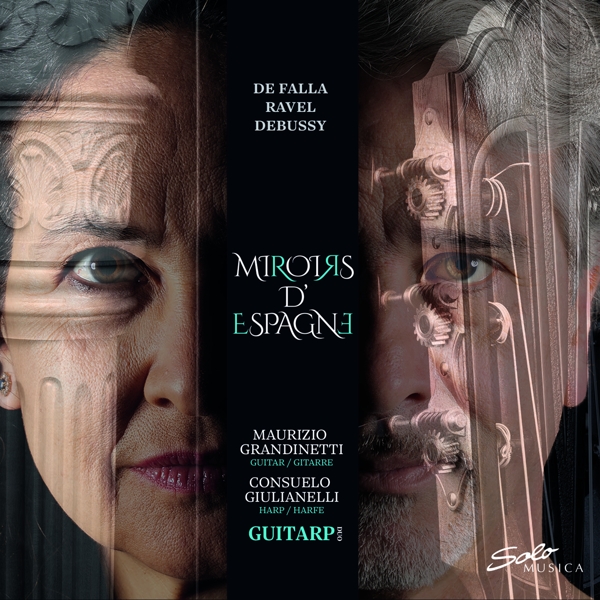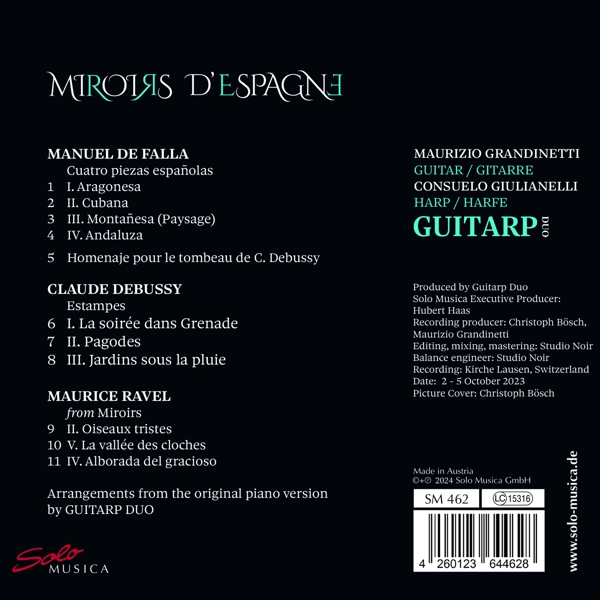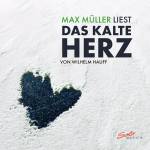Your search:
No selection
Filter results:
|
 |
| Details / Tracklist: |
Piezas espa¤olas Nr. 1-4 01. "Nr. 1 Aragonesa" 01. "Nr. 1 Aragonesa" 02. "Nr. 2 Cubana" 02. "Nr. 2 Cubana" 03. "Nr. 3 Monta¤esa (Paysage)" 03. "Nr. 3 Monta¤esa (Paysage)" 04. "Nr. 4 Andaluza" 04. "Nr. 4 Andaluza" 05. "Homenaje a Claude Debussy" 05. "Homenaje a Claude Debussy"
Estampes (3 Stücke für Klavier) 06. "Nr. 1 La soir?e dans Grenade" 06. "Nr. 1 La soir?e dans Grenade" 07. "Nr. 2 Pagodes" 07. "Nr. 2 Pagodes" 08. "Nr. 3 Jardins sous la pluie" 08. "Nr. 3 Jardins sous la pluie"
Miroirs (5 Stücke für Klavier) (Auszug) 09. "Nr. 2 Oiseaux tristes" 09. "Nr. 2 Oiseaux tristes" 10. "Nr. 5 La vall?e des cloches" 10. "Nr. 5 La vall?e des cloches" 11. "Nr. 4 Alborada del gracioso" 11. "Nr. 4 Alborada del gracioso"
|
 | | Number of discs: |
1 |
 | | Description: | The biographies and the music of Debussy, Ravel, and de Falla contain multiple hidden reflections, many elements that mirror each other. These reflections are so clear-cut that it becomes difficult in many cases to make out the original image. Music inspired by Iberia and the piano as an instrument were certainly common ground, on which the three composers engaged in a lively artistic exchange. The Romantic piano repertoire has appropriated music of the most diverse origins. Considering the particular instrument that originally inspired it, we could almost call the result regeneration rather than mere transcription, as if the music were reborn in its pure form. The works included on this CD showcase guitar, harp and piano in just such a complementary relationship. Indeed, Maurice Ravel personally noted in his score of Miroirs for the pianist Vlado Perlemuter, that he should imitate the guitar or the harp in certain passages. In his article La guitara, Manuel de Falla in his turn writes of how marvellously Debussy depicts the artistic qualities of the instrument, without ever having used the guitar at all in his works. Having grown up with the Romantic tradition, many pianists of the time had difficulties doing justice to the new musical imagery of Symbolism. Chronicles from the time reveal a certain impatience in composers, who required from interpreters a new technique and a different use of the sustaining pedal. Unlike the piano, both guitar and harp emit softer, less defined contours, in keeping with the melancholic and equivocal timbres of Debussy and Ravel.Ever since his student days, Maurizio Grandinettiâ??s main interest has been broadening the musical horizons of his instrument. He is currently soloist, chamber musician and improviser. His career so far has taken him to the most important festivals and concert halls in numerous European countries, Brazil, the USA and China. For 14 years Consuelo Giulianelli was professor for harp at the Stella Matutina Private Music Academy in Feldkirch, Austria. Alongside studies with Mirella Vita and Ursula Holliger, that she completed with distinction, she attended courses by Marielle Nordmann and Pierre Jamet, who premiered the Sonata for Flute, Viola and Harp by Claude Debussy.
- The biographies and the music of Debussy, Ravel, and de Falla contain multiple hidden reflections, many elements that mirror each other. These reflections are so clear-cut that it becomes difficult in many cases to make out the original image. Music inspired by Iberia and the piano as an instrument were certainly common ground, on which the three composers engaged in a lively artistic exchange. The Romantic piano repertoire has appropriated music of the most diverse origins. Considering the particular instrument that originally inspired it, we could almost call the result regeneration rather than mere transcription, as if the music were reborn in it's pure form. The works included on this CD showcase guitar, harp and piano in just such a complementary relationship. Indeed, Maurice Ravel personally noted in his score of Miroirs for the pianist Vlado Perlemuter, that he should imitate the guitar or the harp in certain passages. In his article La guitara, Manuel de Falla in his turn writes of how marvellously Debussy depicts the artistic qualities of the instrument, without ever having used the guitar at all in his works. Having grown up with the Romantic tradition, many pianists of the time had difficulties doing justice to the new musical imagery of Symbolism. Chronicles from the time reveal a certain impatience in composers, who required from interpreters a new technique and a different use of the sustaining pedal. Unlike the piano, both guitar and harp emit softer, less defined contours, in keeping with the melancholic and equivocal timbres of Debussy and Ravel. Ever since his student days, Maurizio Grandinetti's main interest has been broadening the musical horizons of his instrument. He is currently soloist, chamber musician and improviser. His career so far has taken him to the most important festivals and concert halls in numerous European countries, Brazil, the USA and China. For 14 years Consuelo Giulianelli was professor for harp at the Stella Matutina Private Music Academy in Feldkirch, Austria. Alongside studies with Mirella Vita and Ursula Holliger, that she completed with distinction, she attended courses by Marielle Nordmann and Pierre Jamet, who premiered the Sonata for Flute, Viola and Harp by Claude Debussy. |  | | Manufacturer No.: |
SM462 |
 | Product Safety
Responsible Person for the EU:
Solo Musica GmbH
Agnes-Bernauer-Str. 181, 80687 München, DE
info@solo-musica.de |  |
|
There are currently no product reviews.
|  |
|
|
 |
|

















![Ensemble Pallidor / Farnberger Franz / Mühlbacher Al - Bach: Kantaten [Broken Eyes]](https://img.grooves.land/images/cover/541/364/cx0cb1gd.j11)

![Megan Kahts - Händel / Hasse: Arien [Dopo Notte]](https://img.grooves.land/images/cover/493/364/cx0cb1ey.j11)

